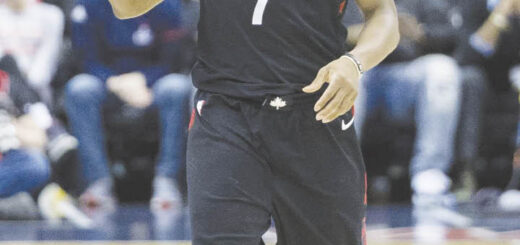Stampede: No clowning around in bull fighting

Photo by Duncan Kinney. Dave Sandilands fashioned his own bull fighter jersey in honour of his Scottish roots.
Very few people would have the cojones to stand in front of a 1,800-pound bull, some might even call them crazy but bull fighter Dave Sandilands does it for the thrills.
“Pure adrenalin rush,” Sandilands replies when asked why he does what he does.
As the Calgary Stampede hit Super Sunday — a prized jewel of the rodeo circuit that sees each winner of the six major events pocket $100,000 — Sandilands assumed his regular position in the infield, watching out for bulls while protecting the cowboys on their backs from stomping hooves.
The Scottish-born cowboy has been fighting bulls for the last 12 years. He started out riding them in high school and college before volunteering to do some bullfighting one day when he had a pair of sweats and some cleats at a rodeo.
“It’s more of a rush to be in front of them than on top of them,” he said.
Gillette, Wyo. bull rider Bobby Welsh, competing in his first Calgary Stampede, said how reassuring it is to have bull fighters around when bull riders are at their most vulnerable.
A lot of people look for the familiar face paint and zany outfits of a rodeo clown when they check out Stampede events but you

Photo by Duncan Kinney. Dave Sandilands never enters the rodeo infield without some tobacco chew tucked away in his attire.
won’t see very much of that these days. Sandilands said that has to do with portraying a more professional and athletic look as they lay their life on the line in the arena.
Sandilands says he keeps fit, “just like everybody else” with his exercise regime. He gave a lot of credit to the Calgary Stampede sports medicine for taking care of the bull fighters.
The exact time rodeo clowns first made their appearance on rodeo circuits is a little hazy bur would have occured in the late ’60s or early ’70s. Rodeo clowns were first introduced to rodeos as just that, clowns. They would entertain the crowd doing different comedic things between rodeo events. When bigger brahma bulls were introduced to rodeos the purpose of the clown remained comedic but became more serious as the clowns assumed the responsibility of distracting the angry bulls as the riders made it to safety.
To visit a museum dedicated to the profession of bull fighting click here
As far as protective gear, there’s not much between a bull fighter and an angry bull; Sandilands pointed out his cleats and soccer socks, with shorts and a hockey jersey. For protection the fighters wear flack jackets and thigh pads; all that topped off with a black cowboy hat.
Sandilands designed his jersey himself of a Scottish flag portraying his heritage with a bull coming out of it.
The Professional Bull Riding (PBR) website says that, “The bullfighter’s uniform has changed over the years. The oversized clothing which once lent itself to the “clown” role has evolved into a loose-fitting jersey and shorts, which allow for maximum movement. The size of the garments serves another purpose: it makes the bullfighter a bigger target”
As far as injuries Sandilands said he hasn’t done too bad just breaking an arm and hurting his head, keeping to the humble cowboy code when he explains that “other guys have been hurt worse.”
In his off time, usually in the fall, Sandilands spends time working his ranch in Esterhazy, Sask.






Wow, nice photos! Especially the last one!
I had the opportunity to see and work as an announcer with the “Sandman” in his early rodeo career and he was the toughest most athletic bullfighter I have ever seen. I’m glad to see he’s working the big shows – he deserves to work them all.
PS. Nice web site as well.
I grew up playing at David’s farm in Scotland and, knowing how he taught myself and my sister to ride the cows and the resident young bulls, Edd and Ernie, I am not surprised that David is now a champion bull fighter!
Poor bulls!